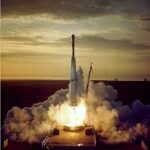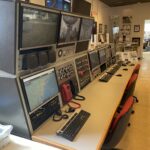 The InfoAge Space Exploration Center.
The InfoAge Space Exploration Center.
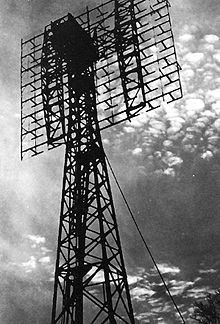 Exhibit 1. The SCR-271-D antenna that was used during Project Diana to demonstrate that the ionosphere could be penetrated at VHF (very high frequencies) from the Earth and from above the Earth. It’s predecessor, The SCR-270 was retrofitted with a larger “bedspring” antenna and higher-power transmitter. It was with this antenna that the Moon Bounce was achieved on January 10, 1946. With that success we could radio to communicate with spacecraft.
Exhibit 1. The SCR-271-D antenna that was used during Project Diana to demonstrate that the ionosphere could be penetrated at VHF (very high frequencies) from the Earth and from above the Earth. It’s predecessor, The SCR-270 was retrofitted with a larger “bedspring” antenna and higher-power transmitter. It was with this antenna that the Moon Bounce was achieved on January 10, 1946. With that success we could radio to communicate with spacecraft.
This site became known as the Diana Site after the history changing Moon Bounce. The team of Project Diana included Col. John DeWitt, E. King Stodola, Harold Webb, Herbert Kauffman and Jacob Mofensen. Mathematician Walter McAfee correctly calculated any point on the moon from any point on the Earth. His calculations made it possible to correctly compensate for the Doppler shift of radio waves from the Earth to the moon which led to the success of the Moon Bounce. The success of the Moon Bounce led to the development of space exploration.
The exhibit also features the radio equipment used by Walter Morrison Sr. W2CXY, an amateur radio enthusiast who in 1959 constructed one of the few 1296 MHz stations that maintained communications using moon bounce techniques. The transmitter and receiver displayed here were ‘home made’ by Walter Morrison with some help by the Eimac Company. Mr. Morrison did not make the first moon bounce but he followed closely those who did.
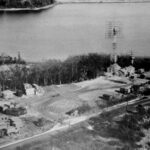 Exhibit 2. The Diana Site in the late 1940’s and early 1950’s continued to be a radar research facility . In this aerial photograph one can see radar trucks, the tower that stands behind the building today, The SCR-271 as well as smaller antennas used for radar research. Notice the minimal housing development that there is along the Belmar shore of the Shark River. The SCR-271 was later disassembled.
Exhibit 2. The Diana Site in the late 1940’s and early 1950’s continued to be a radar research facility . In this aerial photograph one can see radar trucks, the tower that stands behind the building today, The SCR-271 as well as smaller antennas used for radar research. Notice the minimal housing development that there is along the Belmar shore of the Shark River. The SCR-271 was later disassembled.
Exhibit 3. Project SCORE ( Signal Communication by Orbiting Relay Equipment) was established by President Eisenhower to develop rocket technology. After the success of the Moon Bounce and the launch of Sputnik by the Russians in 1957, the space race began prompting quick development of machines that could orbit the earth and communicate. The United States’ first satellite, Explorer 1 was being built but our biggest challenge was developing the rockets needed to place satellites in orbit. We knew that the German V2, which was a terrifically successful guided missile, albeit terrifically destructive, could be a model for building great rockets. During Operation Paperclip the U.S.A. gave asylum to rocket scientists such as Werner Von Braun who helped build the V2 and could help us build better rockets. With the dissolution of NACA, The National Advisory Committee for Aeronautics on October 1, 1958, NASA, The National Air and Space Administration was established, ushering in a new age of space exploration.
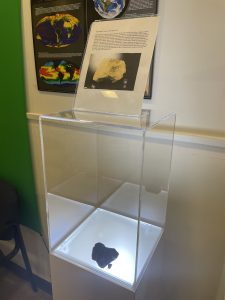 Exhibit 4. Meteorite 50,000 years ago a giant meteorite traveling at 26,000 mph struck the desert floor forming a massive crater 0.74 miles in diameter and 550 feet deep, now known as Arizona’s celebrated Meteor Crater. These amazing iron meteorites are part of the cosmic impact. The ground-breaking meteor expert H.H. Nininger studied Meteor Crater for many years during the 1940’s and 50’s and found specimens miles from the site of impact. Ancient Native Americans are also believed to have used and transported fragments of the meteorite, and may have regarded them as sacred objects which fell from the sky. The crater is not a national park, but a privately owned feature. a ban on meteorite hunting is now strictly enforced by the owners and specimens of this historic and important meteorite are difficult to obtain. These pieces come out of an old collection and were legally collected before the ban. Meteor Crater was the worlds first recognized meteorite crater and was also a training ground for Apollo Astronauts who went to the moon in the 1960’s and 70’s.
Exhibit 4. Meteorite 50,000 years ago a giant meteorite traveling at 26,000 mph struck the desert floor forming a massive crater 0.74 miles in diameter and 550 feet deep, now known as Arizona’s celebrated Meteor Crater. These amazing iron meteorites are part of the cosmic impact. The ground-breaking meteor expert H.H. Nininger studied Meteor Crater for many years during the 1940’s and 50’s and found specimens miles from the site of impact. Ancient Native Americans are also believed to have used and transported fragments of the meteorite, and may have regarded them as sacred objects which fell from the sky. The crater is not a national park, but a privately owned feature. a ban on meteorite hunting is now strictly enforced by the owners and specimens of this historic and important meteorite are difficult to obtain. These pieces come out of an old collection and were legally collected before the ban. Meteor Crater was the worlds first recognized meteorite crater and was also a training ground for Apollo Astronauts who went to the moon in the 1960’s and 70’s.
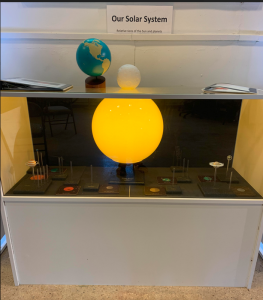 Exhibit 5. Our Solar System Our solar system consists of our star, the Sun, and everything bound to it by gravity — the planets Mercury, Venus, Earth, Mars, Jupiter, Saturn, Uranus and Neptune, dwarf planets such as Pluto, dozens of moons and millions of asteroids, comets and meteoroids. This scale model gives a sense of the relative size of the planets in comparison to the Sun.
Exhibit 5. Our Solar System Our solar system consists of our star, the Sun, and everything bound to it by gravity — the planets Mercury, Venus, Earth, Mars, Jupiter, Saturn, Uranus and Neptune, dwarf planets such as Pluto, dozens of moons and millions of asteroids, comets and meteoroids. This scale model gives a sense of the relative size of the planets in comparison to the Sun.
Exhibit 6. Vanguard was launched on March 17, 1958 following Explorer 1 on 1/31/58 and Explorer 2 on 3/5/58 which did not reach orbit due to a rocket failure at launch. Vanguard was the most advanced and successful of these satellites and although communication with the satellite was lost in 1964, it remains the oldest man-made object still in orbit, together with the upper stage of its launch vehicle. This exhibit displays a prototype Vanguard at full scale. It features six solar cells mounted on the body of the satellite. Six short antenna protrude from the satellite. Vanguard was used to track the effects of the space environment on a satellite and its systems in Earth orbit. It also was used to obtain geodetic measurements through orbit analysis. Vanguard is expected to orbit the earth for 240 years from date of deployment.
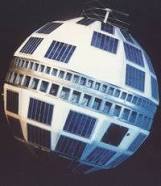 Exhibit 7. was developed by AT&T Bell Labs in 1960.
Exhibit 7. was developed by AT&T Bell Labs in 1960.
Telstar 1 launched on top of a Thor-Delta rocket on July 10, 1962, following the success of Vanguard. Covered in solar panels along with an array of sensors and transmitters at its perimeter, it successfully relayed through space the first television pictures, telephone calls, telegraph and provided the first live transatlantic television feed sent by France of a concert featuring Yves Montand singing “La Chansonette”, a love song.
The original Telstar was part of a multi-national agreement among AT&T Bell Telephone Laboratories (USA), NASA (USA), GPO (United Kingdom) and the National PTT (France) to develop experimental satellite communications over the Atlantic Ocean.
Exhibit 8. The Thor-Able Rocket was an American expendable launch system that was used for a series of re-entry vehicle tests and satellite launches between between 1958 and 1960 It was a two stage rocket consisting of a Thor IRBM as a first stage and a Vanguard-derived able second stage. On some flights, an Altair solid rocket motor was added as a third stage. It was a member of the Thor family and an early predecessor of the Delta.
The final flight of a Delta IV Heavy rocket ocurred on April 09, 2024
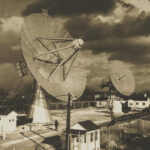 Exhibit 9. The TLM-18 Automatic Tracking Telemetry Antenna was installed for the work that the Army Signal Corps were doing here at the Diana Site in the mid 1958.
Exhibit 9. The TLM-18 Automatic Tracking Telemetry Antenna was installed for the work that the Army Signal Corps were doing here at the Diana Site in the mid 1958.
Built by Radiation Inc (later the Harris Corporation) it would become integral to the work done at the Diana Site. It was used to track weather satellites and was part of The Minitrack System used to track the flights of Sputnik, Vanguard, Explorer, and other early space efforts.The smaller dish next to the TLM-18 was used for research, including finding out if it would be possible to send and receive bounced signals from and to transmitters and receivers at a distance including those at the Deal Test Site, as well as transmitters and receivers that were not our own.
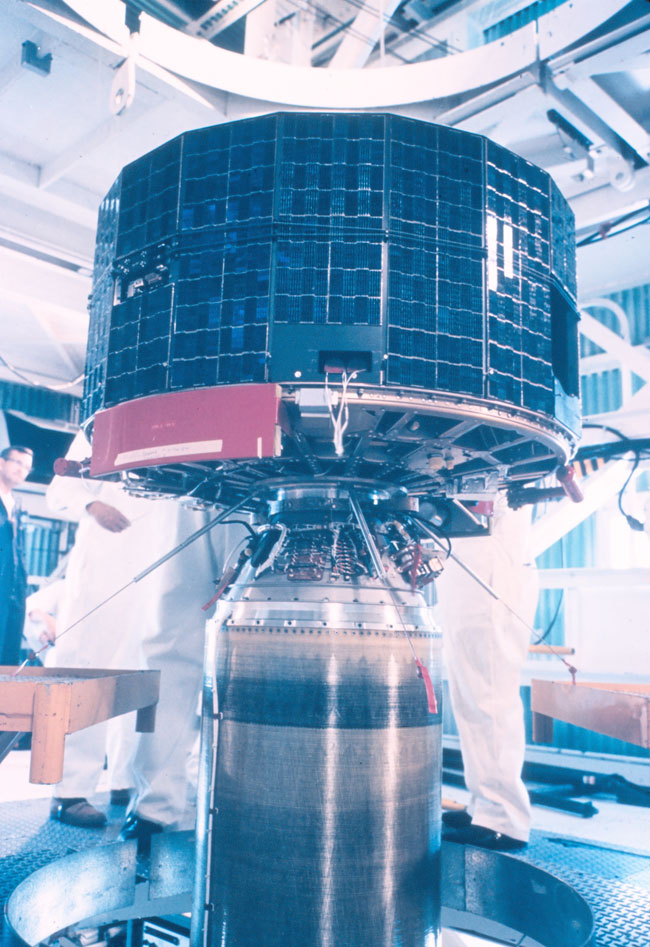
Exhibit 10. The TIROS-1 spacecraft was launched by NASA and partners at 6:40 AM EST on April 1, 1960, from Cape Canaveral,Florida, in the United States. Mission partners were NASA, the U.S. Army Signal Research and Development Laboratory, RCA, the U.S. Weather Bureau, and the U.S. Naval Photographic Interpretation Center. The goal was to improve satellite applications for Earth-bound decisions including evacuations due to an approaching hurricane.
The TLM-18 captured the first image of a hurricane transmitted by Tiros. That image was downloaded, printed, put on a helicopter, sent to The White House and placed on the presidents desk. We now know this technology could save millions of lives and the TLM-18 was part of that development. The Diana Site is often referred to as the Tiros Site as the TLM-18 was used for tracking Tiros Weather Satellites. There have been many Tiros Satellite launches and here at the ISEC using the TLM-18, we receive data from Tiros NOAA weather satellites today.
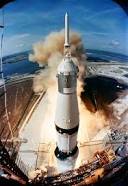 Exhibit 11. The Saturn V (pronounced “Saturn Five”) was an American human-rated expendable rocket used by NASA between 1967 and 1973. The three-stage liquid-fueled super heavy-lift launch vehicle was developed to support the Apollo program for human exploration of the Moon and was later used to launch Skylab, the first American space station.
Exhibit 11. The Saturn V (pronounced “Saturn Five”) was an American human-rated expendable rocket used by NASA between 1967 and 1973. The three-stage liquid-fueled super heavy-lift launch vehicle was developed to support the Apollo program for human exploration of the Moon and was later used to launch Skylab, the first American space station.
The Saturn V was launched 13 times from the Kennedy Space Center in Florida with no loss of crew or payload. The Saturn V was the tallest, heaviest, and most powerful (highest total impulse) rocket ever brought to operational status, and holds records for the heaviest payload launched and largest payload capacity to low earth orbit (LEO) of 140,000kg (310,000lb), which included the third stage and unburned propellant needed to send the Apollo Command / Service, lunar module to the Moon.
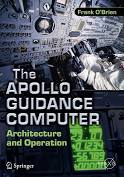 Exhibit 12. The Apollo Guidance Computer Modules are part of a digital computer produced for the Apollo program that was installed on board each Apollo Command Module(CM) and Lunar Module(LM). The AGC provided computation and electronic interfaces for guidance, navigation, and control of the spacecraft. The AGC has a 16-bit word length, with 15 data bits and one parity bit. Most of the software on the AGC is stored in a special read-only memory known as core rope memory, fashioned by weaving wires through magnetic cores, though a small amount of read-write core memory is available. Frank O’Brien, our resident NASA Jet Propulsion Laboratories Solar System Ambassador, wrote the book on the Apollo Guidance computer. He speaks at ISEC on the last Sunday of every month about NASA and Space Exploration.
Exhibit 12. The Apollo Guidance Computer Modules are part of a digital computer produced for the Apollo program that was installed on board each Apollo Command Module(CM) and Lunar Module(LM). The AGC provided computation and electronic interfaces for guidance, navigation, and control of the spacecraft. The AGC has a 16-bit word length, with 15 data bits and one parity bit. Most of the software on the AGC is stored in a special read-only memory known as core rope memory, fashioned by weaving wires through magnetic cores, though a small amount of read-write core memory is available. Frank O’Brien, our resident NASA Jet Propulsion Laboratories Solar System Ambassador, wrote the book on the Apollo Guidance computer. He speaks at ISEC on the last Sunday of every month about NASA and Space Exploration.
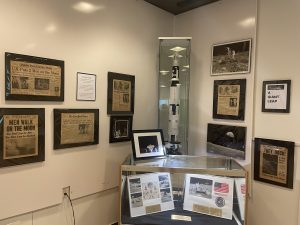 Exhibit 13. A Giant Leap to commemorate the 50th Anniversary of the Apollo Moon Mission, this exhibit was installed. The exhibit features a scale model of the Saturn 5 Rocket, a Flag that was part of Apollo 15 and was taken to the Moon as well as photographs of the Apollo 15 crew, Dave Scott, Al Worden and Jim Irwin. Included are photos of the RCA Lunar Rover used during the mission.
Exhibit 13. A Giant Leap to commemorate the 50th Anniversary of the Apollo Moon Mission, this exhibit was installed. The exhibit features a scale model of the Saturn 5 Rocket, a Flag that was part of Apollo 15 and was taken to the Moon as well as photographs of the Apollo 15 crew, Dave Scott, Al Worden and Jim Irwin. Included are photos of the RCA Lunar Rover used during the mission.
The exhibit also features the original front page of The New York Times, The Daily News, and the Asbury Park Press headlining the historic event of Apollo 11 and the first moon landing that were published on July 19, 1969, the day that mankind landed on the Earths moon.
Exhibit 14. The Control Console for TLM-18 is used in conjunction with Princeton University to observe Pulsars, Stars, Interstellar Space and M31 (The Andromeda Galaxy) by observing the 21cm hydrogen radiation. We use the TLM-18 to observe NOAA Weather Satellites and download images of the weather along the East Coast of the United States.
The TLM-18 still does the Moon Bounce and we complete EME (Earth Moon Earth) transmissions when the moon is available using a Kenwood TS-2000 at a frequency of approximately 1296 MHz.
